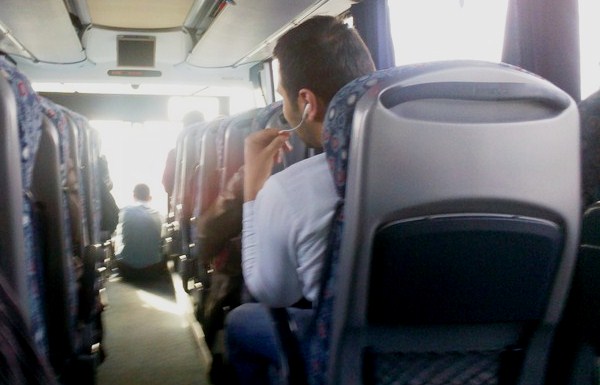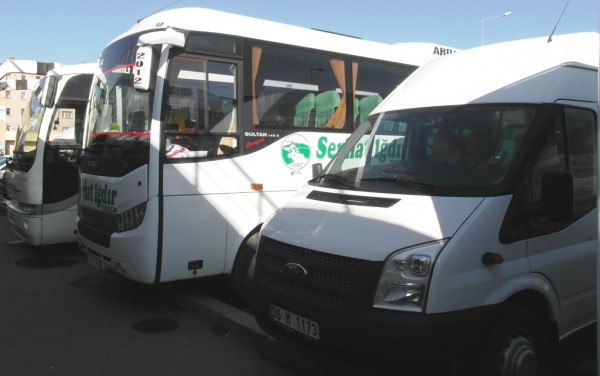
I stepped out of the Otogar metro station in Istanbul and looked around me in awe. I had no idea where to go next. I was expecting a single bus station with a few dozen buses sitting out front – not over 100 offices for various bus companies forming a circle around the metro station.
This was my first clue that traveling by bus in Turkey would be like nothing I ever experienced in the past.
Traveling by bus, even overnight bus, is nothing new for me during this year of traveling. Bus travel is quite common in the Baltics and I went from Riga to Vilnius, Vilnius to Warsaw, Warsaw back to Vilnius and Vilnius to Minsk all by bus. On top of that, all of my inter-country travel in Ukraine was by bus or mini-bus. Not that any of those experiences were bad per se, but compared to Turkey, I was definitely missing out!
So what can you expect when traveling by bus through Turkey?
Buses in Turkey are quite comfortable.
They are large coaches which seem to be at least somewhat climate-controlled. Many come with seatback television screens that play anything from Turkish television shows to American movies. Waiters come by offering coffee, tea or soft drinks and even snacks. Some buses even offer free wi-fi (although I did not manage to access it on any of the buses I took).
Adding to the comfort factor, I personally appreciated that in Turkey, they seat people by gender on buses. On my overnight bus trips in particular, I simply felt a little bit better knowing that I would be seated next to a woman (even if it turned out to be a woman who coughed continuously, cried out “oy” on occasion, farted sporadically and took over half of my seat).
Bus rest stops in Turkey are impressive.
Buses generally stop every hour and a half or so and most of our stops offered a variety of shops and restaurants and, of course, toilets. And although they were all squat toilets, they were at least quite clean! Stops tended to last about thirty minutes, giving you plenty of time to take care of business and grab a bite to eat or something to drink. The only downside of these frequent stops was on the overnight buses – just as I seemed to fall asleep, I would wake up as they turned on the lights at a stop.

Purchasing tickets was easy.
When I first started looking into bus travel in Turkey, Anil Polat of foXnoMad sent me links to several bus companies (see below) – some websites were in English, some in Turkish, but all were easy to navigate and search for schedules. Unfortunately, when I went to book, I got rejected because I didn’t have a Turkish credit card.
Not to worry, as it turned out, going directly to the station was just as easy – maybe even easier.
For example, when I went to the office of Metro Turizm in Amasya to purchase my ticket for an overnight bus to Trabzon, the transaction went down something like this:
Me: “Trabzon” (as I point to the word for Saturday in my Turkish phrase book)
Clerk: Writes down 22:15 on a post-it note, indicating the departure time.
Me: Nods.
Clerk: Points to Saturday on the small calendar sitting on the desk.
Me: Nods.
Clerk: Waves me behind the counter to look at a computer screen and choose my seat.
Me: Points to window seat #12.
Clerk: Writes “40 TL” on a post-it note – the price of my ticket.
Me: Hand the clerk a 50 lira bill and wait as he runs around the corner to find change.
Clerk: Hands me a pen and post-it note and points to me, indicating I need to write my name.
Me: Write my name.
Clerk: Hands me my ticket and says “otogar” – presumably reiterating that the bus leaves from the bus station.
I left the office less than five minutes after I entered, ticket in hand.
A few days later, I repeated basically the same transaction at an office in Trabzon, heading to Erzurum.
Buying my ticket from Erzurum to Kars proved to be even easier. As I stepped out of my taxi at the otogar in Erzurum, a man rushed over to me and asked “Kars?” As one of the most popular destinations from Erzurum, it was a good guess. I followed him inside to a ticket counter, where I simply handed over 15 lira and a man wrote out my ticket by hand for what turned out to be a very under-sold mini-bus heading to Kars thirty minutes later.
Bus companies provide shuttles to and from the city center.
As I read introductions to various cities in my guidebook, I noticed that the long-distance bus stations tended to be located anywhere from 3 to 5 kilometers outside of the center of town. This did not thrill me, as I figured it meant I would either have to stuff myself and my backpack into a local bus or dolmus or spend extra bucks on a taxi.
Luckily, I was mostly wrong. As it turned out, many of the major bus companies run shuttles between the center of the city to the otogar. So when I arrived in Amasya, I was ushered into a mini-van which dropped me off just a couple blocks from my hotel. The same was true in Trabzon, where I also enjoyed a shuttle back to the otogar for my departure as well. This was a perk I had not experienced while traveling by bus anywhere else and it was a very welcome one.
In the end, traveling by bus in Turkey was far better than I expected – and one of the best bus travel experiences I have encountered. If you are looking for an inexpensive, and often scenic, way to travel around Turkey, I can definitely recommend it.
Bus companies to try:
Have you traveled by bus in Turkey or elsewhere? What was your experience like?
Photos: 1 courtesy of Flickr user yellow book; 2 & 3 courtesy of Andrew Couch


